About strange pistols
 Bashny.Net
Bashny.Net
About strange pistols.
Since Monday is still not over, and the corresponding headings shizomilitaristicheskoy long gone, I will refresh a minute theme. Today, once again stumbled upon a remarkable switch dedicated to a variety of exotic gunshot, and some there the articles so imbued with that decided to share them with you. This, it turned out, only pistols - but very different, each of which is somewhat unusual. Photo of the cut is a kind of a spoiler - it shows the last two samples from this post. Yes, you can see bad - well, sho do.
Writes Alexander crest is 11 photos, via livejournal.
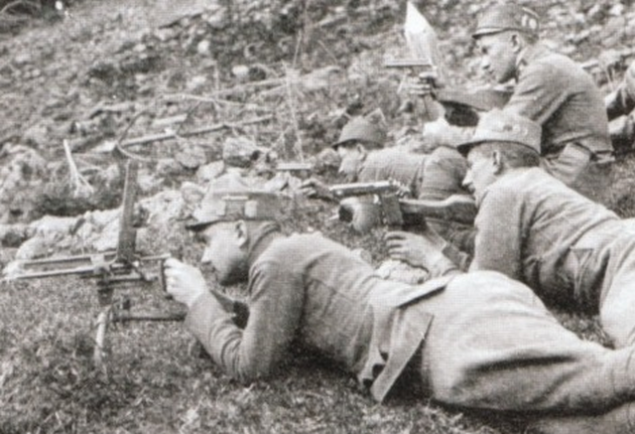
Pistols Ebetsa
In 1894, the American Charles J.. Ebets (Carl J. Ehbets) filed a patent application, which offers self-loading pistol with automatic vapor. The principle was quite curious and very similar to the traditional gas operated mechanism for implementation - withdrawn from the barrel through the cross-hole powder gases enter into the chamber under the barrel, where the piston is pushed back that two rods on the sides of the gun, turned the bolt, unlocking it, then then the shutter moves back under the effect of residual pressure in the barrel (the function of the piston was precisely unlocked the gate ago, he did not move, as opposed to the later systems). Top five rounds placed in front of the trigger guard and can be recharged either from the top, using clips similar to the then rifles and side, one patron, through the hinged cover. A prototype of the pistol was even made in the metal - save your photos. Alas, the caliber, which was made under this pattern is unknown, and his fate is uncertain - we only know that in production it did not go, stay in one or more copies. A pity - beautiful gun. And asks for any steampunk or, say, a fantastic Westen type Firefly.
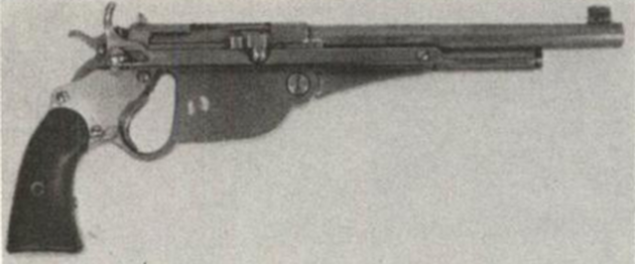
By the way, this Ebets not give up, and in 1897 introduced another version of the gun. That is, in fact, he had a lot of them, and patents obtained by a whole bunch of them, but the stage of implementation of the "in kind" lasted only two samples - about which we are. Gun Ebetsa 1897 had automation, are strongly reminiscent of the device gun Colt-Browning M1895, also known by the nickname "Potato" and his shop was much more common for a modern look - was located in the arm and was replaced. A lot of attention in the design was paid to safety and reliability of operation of the arrow - is what many inventors lone working on breakthrough projects overlooked. In particular, it has been structurally completely exclude the possibility of separation gate followed by his flight in the face of the shooter (the earlier sin Colt, for example). The gun was introduced by Colt as a potential model for the production of - ironically, Ebets did it together with John Browning, who brought her to the same prototype. Preference was given to the system of Browning himself Ebets, examined both pistols, he acknowledged that his work really is noticeably inferior to the majority of parameters. That did not stop them from Browning become friends continue to work closely together.
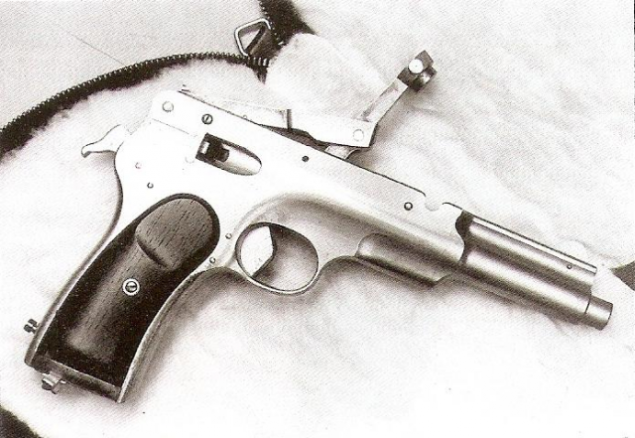
Adler
This small civilian gun was manufactured by the German company Adlerwaffenwerke in 1906-07 years. The design was not very remarkable - ordinary gun with a single in the store in the handle and an automatic gate at the free, no time dozens of models produced. Remarkable appearance and the fact that shutter, unlike most pistols completely hidden in the housing. Arm cocking up and withdrawn, until the pile is full (in the sense that it propylene sighting slot). Despite the fact that the machine was produced commercially and sold on the civilian arms market, get it in these days is not easy - it was released less than a hundred pieces. And even if you manage to get it, shoot will not work for sure - the gun is designed for a special cartridge of caliber 7, 25 mm bottle sleeve, manufactured by the same company and do not use anywhere else, these days, these cartridges remain literally in a few instances.

Gun grabs
In 1943, George F. grab somebody (George F. Grebey), who worked in the company Winchester, he suggested that the US Department of Defense first, probably, in the world (with the exception of DIY) project "opistolechennoy rifle." More precisely, the rifle - grab participated in the work on M1 carbine and its design was inspired. The gun had a caliber .30 Carbine, shutter cocking carbine, a handle located on the side (just to the left, not the right, as in M1), the mine was to store the trigger guard - Use of the same shops M1 capacity of 20 and 30 rounds. The gun was offered as a weapon for the paratroopers and special forces, but was rejected as expected - the military has been the one carbine M1, which, although it was longer and harder, but have normal organ retention and allows you to aim fire. As shown itself in terms of convenience and accuracy of shooting an arrow gun Grady (and showed it at all) - history is silent. What is clear is that the pandora 35 cm in length (the weight is not known, but hardly less than two kilograms), equipped with only one handle Revolver and shoot at the same time a patron of high power - weapons more suited to the heroes of video games and anime characters than real life .
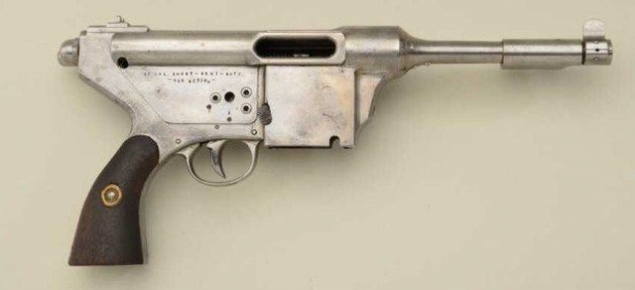
HAFDASA / Zonda
Small and very elegant pocket pistol chambered for .22 LR - it produced the Argentine firm HAFDASA, better known for its clones Colt M1911 (issued under the series name Ballester-Molina). Actually, this was their product, apparently, so neprioriteten at the time of that even a single name is not rewarded, and therefore simply called HAFDASA. However, this gun has a very remarkable design - it shoots with an open shutter, as the sub-machine gun. The gate is located within the tubular slide box, cocked two side window (one of which served as a parallel and ejection port) - arrows bows his fingers on the sides (aided by notches on the gate) and pulls back to arming. In the late 1950s, when the company went bankrupt, this pistol was the only model that was made on it at the time.

Some time later, several former employees HAFDASA organized a new company and began to produce her gun called Zonda. It was a version of the familiar pistol HAFDASA, differed in just a few changes. First, the window in the slide only one box left, right (the very thing that is thrown through the sleeve), and shutter now had cocked by hooking your fingertip to the deepening of the ejector - much less convenient, but apparently felt that the two windows collect too much dirt from the pocket of the owner. The second interesting feature - the construction of a fuse. He did not lock and blocks - it is trite and simply shifts the store a little down in the mine, so that the valve motion is not hitched from his patron. In other words, absolute reliability - accidental discharge is eliminated in principle. Alas, Zonda sold poorly and was soon discontinued.
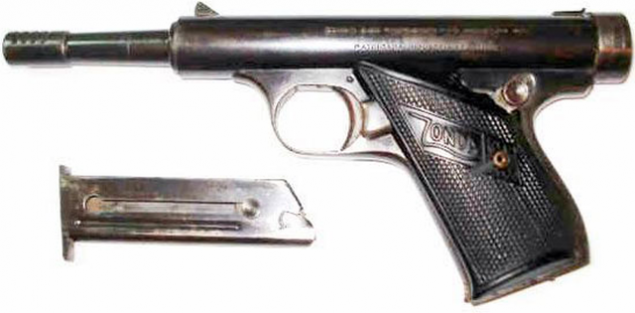
Steyr M12 / P16 Doppel
And now pretty good beautiful designs over and began adische. No, I do not know how to actually call it, but since it two pistols Steyr M12 / P16, united together, then wrote something like this. Question rapid-infantry weapons during the First World powers various decided differently, as well as the experience, no one was, and then it's a whole new world for all, then get scared sometimes. Here, for example, the Austro-Hungarian pistol Steyr M12 - itself one more Shush. Store in the arm, but not interchangeable, charging clip above. There he ushushennaya version - actually Steyr M12 / P16. The same, but the store is longer (holds 16 rounds instead of 12) and is able to fire bursts. And as if that was not enough, in 1917 the Austrians gash Spark these guns here. The special frame in which they are both attached, fastened to the frame butt and placed midway between pistols sights. Common descent is done, which allows firing pistols at a time, and if perverted, then a volley of both. This stuff was in the amount of naklёpano azhno hundred (!) Pieces. Combat effectiveness, however murky secrets - information about whether to use it at the front, and, if so, how successful was not found.

Frommer Stop M17
"We need more of hell!" - Decided the Austro-Hungarian military, looking at the previous sample, and gave rise to light something that I have no adjectives. I can understand trying to make a sub-machine gun from a couple of pistols - if it's powerful army guns such as Steyr M12. But the production of machine-gun from a pair of pocket pistols Frommer Stop - is beyond me. Frommer Stop as such, by the way, is also one more masterpiece of weapons genius - uses automatic long recoil, which is not enough that exotic enough in itself, so still and quite redundant for the feeble Browning cartridges 7, 65 mm and 9 mm short, who fired the gun. So the recipe for success: take the said Frommer Stop (does not specify which of the two gauges) Cut down he whispered, giving the possibility of firing bursts, lengthen the barrel three times (one must at least some aiming to provide the range), the trigger change from the normal hook the trigger, located in machine gun on the back plate as well as supply the store very long, extra details such as the handle schёchek remove fuck to reduce the cost structure ...
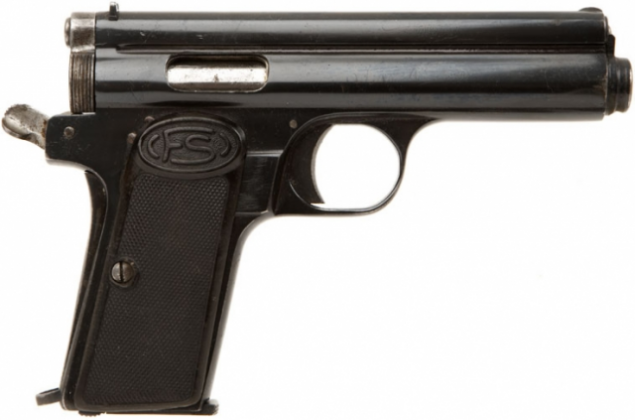
Frommer Stop M17 machine gun in the version
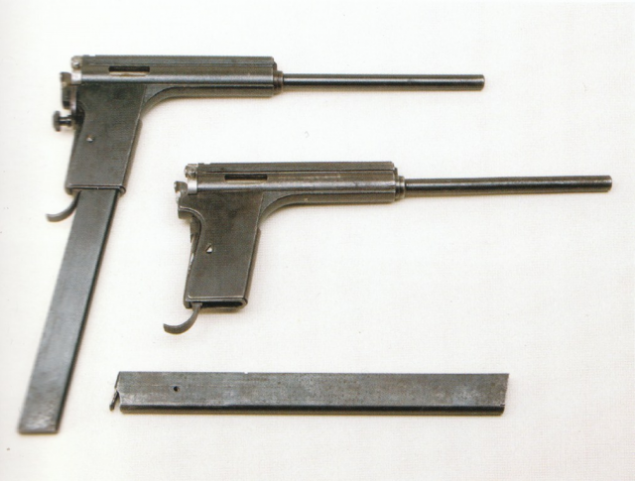
Then here's a pair of ratchets mounted upside down (to facilitate the replacement stores) on a machine with a tripod. It is evident that the Austrians tried to make an analog machine-gun Italian-gun Villar Perosa M15, which had largely similar design (only development was special, not ersatz pistol from his pocket). At the end of the test, however, soon realized that it is better not to show off and listen to the song about the boots - I mean, instead of just imitations htonichnyh slyamzili original - it did, starting release replica "Italian" called MP18.
Posted in [mergetime] 1402342416 [/ mergetime]
I finished. Stories about the weapon, you can read endlessly, especially about such rare instances. I will try a fresh mind tomorrow to continue the theme.

Since Monday is still not over, and the corresponding headings shizomilitaristicheskoy long gone, I will refresh a minute theme. Today, once again stumbled upon a remarkable switch dedicated to a variety of exotic gunshot, and some there the articles so imbued with that decided to share them with you. This, it turned out, only pistols - but very different, each of which is somewhat unusual. Photo of the cut is a kind of a spoiler - it shows the last two samples from this post. Yes, you can see bad - well, sho do.
Writes Alexander crest is 11 photos, via livejournal.

Pistols Ebetsa
In 1894, the American Charles J.. Ebets (Carl J. Ehbets) filed a patent application, which offers self-loading pistol with automatic vapor. The principle was quite curious and very similar to the traditional gas operated mechanism for implementation - withdrawn from the barrel through the cross-hole powder gases enter into the chamber under the barrel, where the piston is pushed back that two rods on the sides of the gun, turned the bolt, unlocking it, then then the shutter moves back under the effect of residual pressure in the barrel (the function of the piston was precisely unlocked the gate ago, he did not move, as opposed to the later systems). Top five rounds placed in front of the trigger guard and can be recharged either from the top, using clips similar to the then rifles and side, one patron, through the hinged cover. A prototype of the pistol was even made in the metal - save your photos. Alas, the caliber, which was made under this pattern is unknown, and his fate is uncertain - we only know that in production it did not go, stay in one or more copies. A pity - beautiful gun. And asks for any steampunk or, say, a fantastic Westen type Firefly.

By the way, this Ebets not give up, and in 1897 introduced another version of the gun. That is, in fact, he had a lot of them, and patents obtained by a whole bunch of them, but the stage of implementation of the "in kind" lasted only two samples - about which we are. Gun Ebetsa 1897 had automation, are strongly reminiscent of the device gun Colt-Browning M1895, also known by the nickname "Potato" and his shop was much more common for a modern look - was located in the arm and was replaced. A lot of attention in the design was paid to safety and reliability of operation of the arrow - is what many inventors lone working on breakthrough projects overlooked. In particular, it has been structurally completely exclude the possibility of separation gate followed by his flight in the face of the shooter (the earlier sin Colt, for example). The gun was introduced by Colt as a potential model for the production of - ironically, Ebets did it together with John Browning, who brought her to the same prototype. Preference was given to the system of Browning himself Ebets, examined both pistols, he acknowledged that his work really is noticeably inferior to the majority of parameters. That did not stop them from Browning become friends continue to work closely together.

Adler
This small civilian gun was manufactured by the German company Adlerwaffenwerke in 1906-07 years. The design was not very remarkable - ordinary gun with a single in the store in the handle and an automatic gate at the free, no time dozens of models produced. Remarkable appearance and the fact that shutter, unlike most pistols completely hidden in the housing. Arm cocking up and withdrawn, until the pile is full (in the sense that it propylene sighting slot). Despite the fact that the machine was produced commercially and sold on the civilian arms market, get it in these days is not easy - it was released less than a hundred pieces. And even if you manage to get it, shoot will not work for sure - the gun is designed for a special cartridge of caliber 7, 25 mm bottle sleeve, manufactured by the same company and do not use anywhere else, these days, these cartridges remain literally in a few instances.

Gun grabs
In 1943, George F. grab somebody (George F. Grebey), who worked in the company Winchester, he suggested that the US Department of Defense first, probably, in the world (with the exception of DIY) project "opistolechennoy rifle." More precisely, the rifle - grab participated in the work on M1 carbine and its design was inspired. The gun had a caliber .30 Carbine, shutter cocking carbine, a handle located on the side (just to the left, not the right, as in M1), the mine was to store the trigger guard - Use of the same shops M1 capacity of 20 and 30 rounds. The gun was offered as a weapon for the paratroopers and special forces, but was rejected as expected - the military has been the one carbine M1, which, although it was longer and harder, but have normal organ retention and allows you to aim fire. As shown itself in terms of convenience and accuracy of shooting an arrow gun Grady (and showed it at all) - history is silent. What is clear is that the pandora 35 cm in length (the weight is not known, but hardly less than two kilograms), equipped with only one handle Revolver and shoot at the same time a patron of high power - weapons more suited to the heroes of video games and anime characters than real life .

HAFDASA / Zonda
Small and very elegant pocket pistol chambered for .22 LR - it produced the Argentine firm HAFDASA, better known for its clones Colt M1911 (issued under the series name Ballester-Molina). Actually, this was their product, apparently, so neprioriteten at the time of that even a single name is not rewarded, and therefore simply called HAFDASA. However, this gun has a very remarkable design - it shoots with an open shutter, as the sub-machine gun. The gate is located within the tubular slide box, cocked two side window (one of which served as a parallel and ejection port) - arrows bows his fingers on the sides (aided by notches on the gate) and pulls back to arming. In the late 1950s, when the company went bankrupt, this pistol was the only model that was made on it at the time.

Some time later, several former employees HAFDASA organized a new company and began to produce her gun called Zonda. It was a version of the familiar pistol HAFDASA, differed in just a few changes. First, the window in the slide only one box left, right (the very thing that is thrown through the sleeve), and shutter now had cocked by hooking your fingertip to the deepening of the ejector - much less convenient, but apparently felt that the two windows collect too much dirt from the pocket of the owner. The second interesting feature - the construction of a fuse. He did not lock and blocks - it is trite and simply shifts the store a little down in the mine, so that the valve motion is not hitched from his patron. In other words, absolute reliability - accidental discharge is eliminated in principle. Alas, Zonda sold poorly and was soon discontinued.

Steyr M12 / P16 Doppel
And now pretty good beautiful designs over and began adische. No, I do not know how to actually call it, but since it two pistols Steyr M12 / P16, united together, then wrote something like this. Question rapid-infantry weapons during the First World powers various decided differently, as well as the experience, no one was, and then it's a whole new world for all, then get scared sometimes. Here, for example, the Austro-Hungarian pistol Steyr M12 - itself one more Shush. Store in the arm, but not interchangeable, charging clip above. There he ushushennaya version - actually Steyr M12 / P16. The same, but the store is longer (holds 16 rounds instead of 12) and is able to fire bursts. And as if that was not enough, in 1917 the Austrians gash Spark these guns here. The special frame in which they are both attached, fastened to the frame butt and placed midway between pistols sights. Common descent is done, which allows firing pistols at a time, and if perverted, then a volley of both. This stuff was in the amount of naklёpano azhno hundred (!) Pieces. Combat effectiveness, however murky secrets - information about whether to use it at the front, and, if so, how successful was not found.

Frommer Stop M17
"We need more of hell!" - Decided the Austro-Hungarian military, looking at the previous sample, and gave rise to light something that I have no adjectives. I can understand trying to make a sub-machine gun from a couple of pistols - if it's powerful army guns such as Steyr M12. But the production of machine-gun from a pair of pocket pistols Frommer Stop - is beyond me. Frommer Stop as such, by the way, is also one more masterpiece of weapons genius - uses automatic long recoil, which is not enough that exotic enough in itself, so still and quite redundant for the feeble Browning cartridges 7, 65 mm and 9 mm short, who fired the gun. So the recipe for success: take the said Frommer Stop (does not specify which of the two gauges) Cut down he whispered, giving the possibility of firing bursts, lengthen the barrel three times (one must at least some aiming to provide the range), the trigger change from the normal hook the trigger, located in machine gun on the back plate as well as supply the store very long, extra details such as the handle schёchek remove fuck to reduce the cost structure ...

Frommer Stop M17 machine gun in the version

Then here's a pair of ratchets mounted upside down (to facilitate the replacement stores) on a machine with a tripod. It is evident that the Austrians tried to make an analog machine-gun Italian-gun Villar Perosa M15, which had largely similar design (only development was special, not ersatz pistol from his pocket). At the end of the test, however, soon realized that it is better not to show off and listen to the song about the boots - I mean, instead of just imitations htonichnyh slyamzili original - it did, starting release replica "Italian" called MP18.
Posted in [mergetime] 1402342416 [/ mergetime]
I finished. Stories about the weapon, you can read endlessly, especially about such rare instances. I will try a fresh mind tomorrow to continue the theme.

Tags
See also
Strange Mesa in the world
Land alienation
He stated or let slip?
10-ka of the strangest places in the world
Last of the Mohicans: A History of Man,
Donation to Japan
Angels and Demons - Physics of Hollywood against
Creepy place where ghosts live
Technical innovations that changed the sport
Yards of our childhood - photo

















